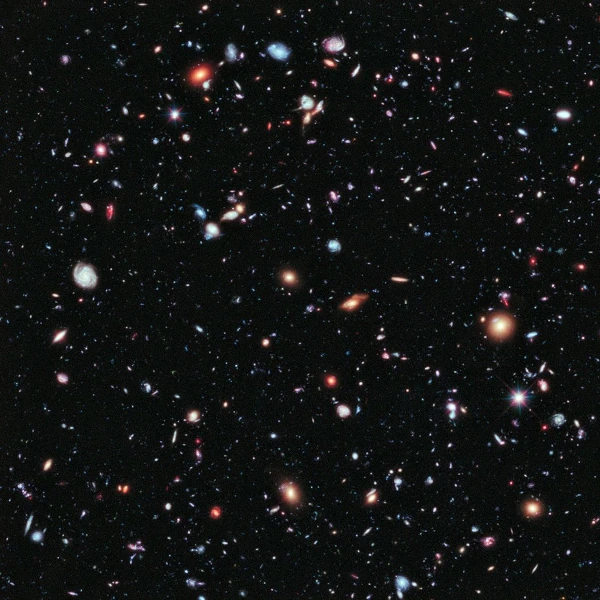
Lançado em 24 de abril de 1990, o Telescópio Espacial Hubble tornou-se um dos instrumentos mais influentes da astronomia moderna. Colocado em órbita a 547 km de altitude, ele escapa da turbulência atmosférica terrestre, oferecendo uma resolução angular de cerca de 0,05 segundos de arco. O Hubble explorou o passado cósmico até desvio para o vermelho \( z > 10 \), revelando galáxias formadas menos de um bilhão de anos após o Big Bang.
Sua câmera WFC3 e seu espectrógrafo COS capturaram a luz de objetos tão distantes que sua radiação visível agora está deslocada para o infravermelho, de acordo com a lei de Hubble: \( v = H_0 \, d \) onde \( v \) é a velocidade de afastamento, \( H_0 \) é a constante de expansão e \( d \) é a distância até a galáxia observada.
N.B.:
O desvio para o vermelho, denotado \( z \), mede a variação do comprimento de onda de uma linha espectral entre a emissão e a observação. É definido pela relação: \( z = \frac{\lambda_{obs} - \lambda_{emit}}{\lambda_{emit}} \)
Um desvio para o vermelho positivo (\( z > 0 \)) corresponde a um desvio para o vermelho, indicando que o objeto está se afastando do observador. Por outro lado, um desvio para o vermelho negativo (\( z < 0 \)) corresponde a um desvio para o azul. Em grande escala, os valores de \( z \) observados para galáxias e quasares são proporcionais à sua distância segundo a lei de Hubble, \( v = H_0 \, d \), assinatura direta da expansão do universo.
Uma das missões principais do Hubble foi a medição precisa da taxa de expansão do universo. Ao observar cefeidas e supernovas do tipo Ia, o Hubble permitiu que Adam Riess (1969–) e Brian Schmidt (1967–) obtivessem um valor para a constante de Hubble em torno de \( H_0 ≈ 73 \, km·s^{-1}·Mpc^{-1} \).
Esses resultados evidenciaram uma tensão entre os valores locais de \( H_0 \) e aqueles deduzidos da radiação cósmica de fundo pelo satélite Planck, que dá \( H_0 ≈ 67,4 \, km·s^{-1}·Mpc^{-1} \). Esse desacordo, conhecido como "tensão de Hubble", sugere que nosso modelo cosmológico \(\Lambda CDM\) pode precisar de revisão.
O Hubble revelou as estruturas complexas das nebulosas, como os famosos Pilares da Criação na Nebulosa da Águia (M16). Essas imagens, capturadas em luz visível e infravermelha, mostram os processos dinâmicos de formação estelar, onde os ventos de estrelas jovens moldam as nuvens moleculares.
Os detalhes dos jatos de objetos HH ou dos discos protoplanetários de Órion ajudaram a compreender os mecanismos de acreção e ejeção de matéria ao redor de protoestrelas.
O Hubble também contribuiu para a espectroscopia de atmosferas exoplanetárias. Ao analisar a luz das estrelas filtrada pelas atmosferas dos planetas durante os trânsitos, detectou a presença de vapor d'água, metano e sódio em vários mundos extrasolares.
Essas observações pioneiras abriram caminho para instrumentos mais recentes, como o JWST, capaz de estudar a composição química dessas atmosferas com maior precisão.
A imagem emblemática do Hubble Ultra Deep Field (2004) reúne cerca de 10.000 galáxias em um minúsculo campo de 11 minutos de arco. Ela ilustra a densidade vertiginosa do cosmos observável: cada ponto luminoso representa uma galáxia inteira contendo bilhões de estrelas.
N.B.:
A magnitude limite atingida pelo Hubble Ultra Deep Field é \( m_{AB} ≈ 30 \), ou seja, objetos 4 bilhões de vezes mais fracos do que aqueles visíveis a olho nu.
Apesar de sua idade, o Hubble permanece como um pilar da observação espacial. Seus dados, arquivados há mais de trinta anos, ainda são usados em pesquisas sobre matéria escura, quasares e morfologia galáctica. A interação entre o Hubble e o James Webb Space Telescope proporcionará agora uma visão complementar do cosmos, combinando ultravioleta e infravermelho profundo.
| Telescópio | Comprimentos de onda observados | Resolução angular | Ano de lançamento | Órbita |
|---|---|---|---|---|
| Hubble | Ultravioleta – Visível – Infravermelho próximo | 0,05″ | 1990 | Órbita terrestre baixa (547 km) |
| James Webb | Infravermelho médio e distante | 0,1″ | 2021 | Ponto de Lagrange L2 (1,5 milhão de km) |
| Chandra | Raios X | 0,5″ | 1999 | Órbita terrestre muito elíptica (10.000 × 140.000 km) |
| Spitzer | Infravermelho (3–180 µm) | 2″ | 2003 | Órbita heliocêntrica (seguindo a Terra) |
| Gaia | Visível (fotometria e astrometria de precisão) | 0,01″ | 2013 | Ponto de Lagrange L2 |
| Kepler | Visível (detecção de trânsitos planetários) | 4″ | 2009 | Órbita heliocêntrica (atrás da Terra) |
| TESS | Visível – infravermelho próximo | 21″ | 2018 | Órbita elíptica alta (P/13,7 dias) |
| ALMA | Ondas milimétricas e submilimétricas | 0,01″ (interferometria) | 2011 | Solo (deserto do Atacama, Chile, 5000 m) |
| Fermi | Raios gama (20 MeV – 300 GeV) | 3′ a 0,1° | 2008 | Órbita terrestre baixa (565 km) |
| Euclid | Visível e infravermelho próximo (mapeamento cosmológico) | 0,2″ | 2023 | Ponto de Lagrange L2 |
Fonte: NASA HubbleSite, ESA, e ADS – Astrophysics Data System.